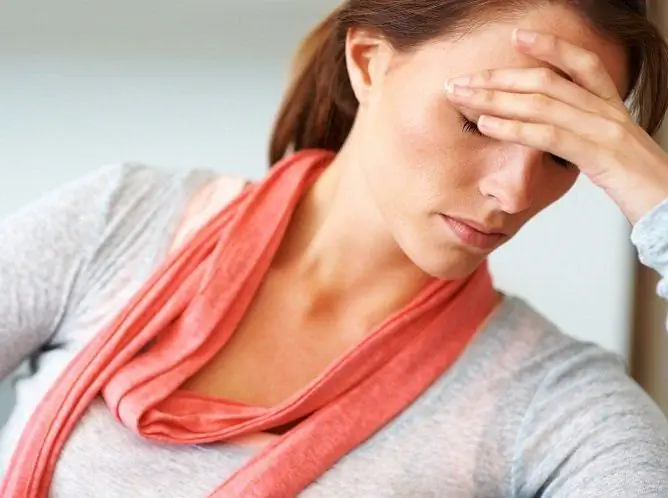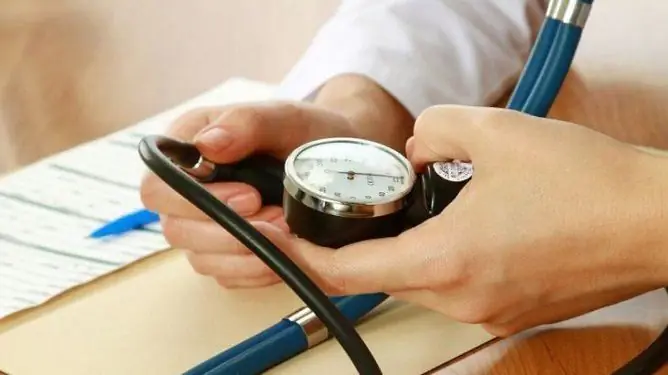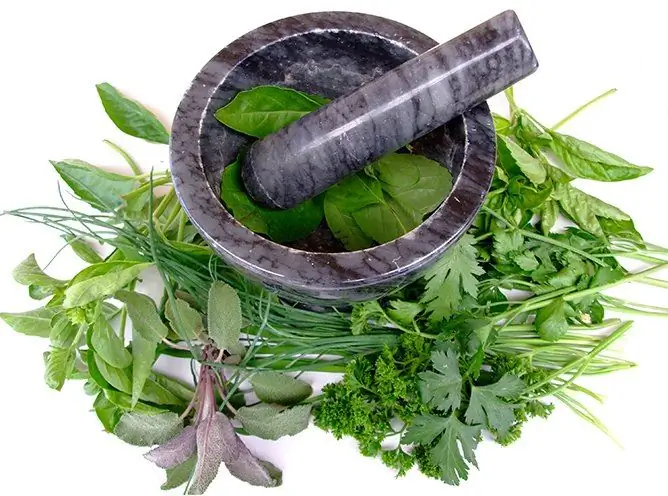- Author Rachel Wainwright [email protected].
- Public 2023-12-15 07:39.
- Last modified 2025-11-02 20:14.
How to lower diastolic blood pressure at home
The content of the article:
- How and when to lower diastolic blood pressure at home without medication
- How to lower diastolic pressure with medications
- What is diastolic pressure and the reasons for its rise
- Symptoms
- Diagnostics
- Video
Not so long ago, the question of how to quickly reduce diastolic pressure (with drugs, folk remedies) was more interested in people of the older age group. However, over the past few decades, diseases of the cardiovascular system have sharply rejuvenated, and now arterial hypertension, including isolated diastolic hypertension, is often detected in young people and even adolescents.

If the rise in pressure is insignificant, you can try to reduce it without resorting to medication.
How and when to lower diastolic blood pressure at home without medication
There are many drugs that can quickly normalize high blood pressure, but they all have a number of side effects. Therefore, with initial hypertension, they try to do without drugs.
A slight increase in diastolic pressure is often associated not with pathological, but physiological reasons. These include:
- abuse of foods and drinks rich in caffeine (strong tea, coffee, energy drinks, cola, cocoa, dark chocolate);
- chronic lack of sleep;
- overwork;
- stress;
- insufficient fluid intake in the heat.
In these cases, it is not only possible, but also necessary to normalize diastolic pressure without resorting to medication. To do this, the patient should eliminate the provoking factor:
- normalize the daily routine and carefully observe it;
- go to bed no later than 22 hours and make sure that the night's sleep lasts at least 8 hours;
- in case of sleep disorders, 30-40 minutes before going to bed, drink half a glass of a decoction of valerian roots (2 teaspoons of crushed medicinal raw materials in a glass of water);
- refrain from drinking drinks rich in caffeine, as well as dark chocolate.
If the pressure rises often, one or more courses of herbal medicine can be carried out (of course, with the approval of the attending physician). Examples of medicinal preparations with a hypotensive effect:
- Mix in one part meadowsweet sprouts, lemon balm leaves, valerian roots, hawthorn fruits, St. John's wort, motherwort herb, peppermint leaves and ½ part of the yellow melilot herb. Pour ½ liter of boiling water over 3 tablespoons of the collection and leave for two hours. Strain. Take ¼ glass 3-4 times a day.
- Mix 4 parts of marsh cinnamon grass, motherwort herb and oregano; 2 parts of sprouts of a drop cap, licorice root; 1 part each of calendula flowers, horse sorrel root, yarrow herb, sweet clover sprouts and black chokeberry berries; 1/2 part peppermint leaves. Rinse the flask of a thermos with boiling water and place 2 tablespoons of the ready-made collection in it. Pour 2.5 cups of boiling water and leave for 8 hours. Strain and take three times a day, ¼-½ cup 15-30 minutes before meals.
How to lower diastolic pressure with medications
Treatment of diastolic hypertension should be aimed at eliminating the cause underlying the pathological mechanism of its development. For example, for hypothyroidism, hormone replacement therapy is prescribed, and for renal artery stenosis, surgery (stenting) is performed. As a result of etiotropic treatment, the patient not only disappears or significantly weakens the symptoms of the underlying disease, but also normalizes blood pressure.
If the cause of diastolic hypertension remains unidentified or therapy of the underlying disease does not lead to normalization of blood pressure, the doctor may recommend taking antihypertensive medications. At the same time, it should be noted that there are no drugs that can reduce exclusively diastolic pressure without lowering systolic pressure, since both lower and upper pressure are two indicators of the functional state of the cardiovascular system, are interconnected and act in isolation on one of them, without affecting the other, is impossible.
How to effectively reduce pressure? The answer to this question depends on the level of indicators, the reason for the increase, the age and general health of the person, the presence or absence of concomitant diseases. The main groups of antihypertensive drugs are:
- Angiotensin-converting enzyme (ACE) inhibitors and angiotensin receptor blockers. These drugs not only lower blood pressure, but also have a cardioprotective effect, increase the sensitivity of tissues to insulin.
- Beta blockers. The mechanism of action is to block receptors that are sensitive to the action of adrenaline. They have a pronounced hypotensive effect, normalize the heart rhythm, and reduce myocardial oxygen demand.
- Calcium antagonists (slow calcium channel blockers). They inhibit the penetration of calcium ions from the intercellular space into the muscle cells of the vascular wall. This leads to a decrease in their tone and expansion of the lumen of blood vessels, as a result of which blood pressure decreases.
- Diuretics (diuretics). As monotherapy for arterial hypertension, they are used extremely rarely, more often they are part of complex therapy together with ACE inhibitors.
- Antispasmodics. Reduces muscle tone, which leads to an expansion of the lumen of blood vessels and a decrease in blood pressure.
Drug therapy should be prescribed and carried out only under the supervision of a physician. It is unacceptable to independently change the doses prescribed by a specialist (strict adherence to both the amount of the drug in mg and the frequency of administration is required) and even more abrupt termination of the therapy.
What is diastolic pressure and the reasons for its rise
When measuring blood pressure (BP), two indicators are determined:
- Systolic (upper, heart) pressure - the pressure of blood on the walls of the arteries at the time of heart contraction, that is, its systole. Its value is determined by the strength and frequency of heartbeats, which is why systolic pressure is also called heart pressure.
- Diastolic (lower, renal) - blood pressure on the vascular walls, recorded at the time of diastole (myocardial relaxation). The value of this indicator depends on the resistance of the peripheral vessels. The strength of vascular tone is greatly influenced by the biologically active substance produced by the kidneys - renin. Its synthesis increases in various kidney diseases, so one of their symptoms is high diastolic pressure.
High blood pressure is called arterial hypertension (hypertension). Most often, there is an increase in both indicators, that is, upper and lower pressure. If the systolic is normal and the diastolic pressure is high (90 mmHg or higher), this condition is called isolated diastolic hypertension. It is caused by various reasons that have a direct effect on vascular tone. For example, diastolic hypertension occurs when:
- severe arterial atherosclerosis;
- kidney disease (chronic glomerulonephritis, renal artery sclerosis, renal failure, polycystic disease, chronic pyelonephritis);
- heart disease (myocarditis, heart failure, cardiosclerosis, cardiomyopathy);
- dysfunction of the thyroid gland (hyperthyroidism or hypothyroidism);
- amyloidosis;
- hormonal imbalance in postmenopausal women.
For the human body, a long-term elevated lower pressure is a potential danger, since it suggests that even at the time of diastole, there is no full relaxation of the heart cavities and the muscles of the blood vessels. This, in turn, increases the risk of developing myocardial infarction, cerebral stroke, and aneurysms.
Symptoms
There are no typical symptoms characteristic only of diastolic hypertension. The development of this condition can be redistributed according to the following signs:
- headache - throbbing, aching or bursting in nature, localized in the parietotemporal, frontal or occipital regions;
- dizziness;
- nausea, there may be repeated vomiting;
- general weakness;
- muscle tremors;
- feeling short of breath;
- cardiopalmus;
- pain in the region of the heart;
- cold clammy sweat.
If one or more of the listed symptoms appear, it is necessary to measure blood pressure using a tonometer. Depending on the lower indicator, diastolic hypertension is divided into several stages:
- Light - from 90 to 99 mm Hg. Art.;
- Average - from 100 to 109 mm Hg. Art.;
- Severe - from 110 mm Hg. Art. and higher.
Diagnostics
The choice of a means that allows you to reduce diastolic pressure, whether it be folk remedies or pills, is carried out by the doctor after examining the patient and establishing the cause of hypertension.

Only a doctor can assess how serious hypertension is, and what needs to be taken to normalize blood pressure.
The examination usually includes:
- consultations with a cardiologist, nephrologist, endocrinologist;
- Ultrasound of the kidneys, thyroid gland;
- urine tests (general analysis, Reberg's test, Zimnitsky's test, Nechiporenko's test);
- angiography of renal vessels;
- biochemical blood test (cholesterol, triglycerides, urea, creatinine);
- blood test for hormonal profile;
- excretory urography.
If necessary, the diagnostic plan can be expanded.
Video
We offer for viewing a video on the topic of the article.

Elena Minkina Doctor anesthesiologist-resuscitator About the author
Education: graduated from the Tashkent State Medical Institute, specializing in general medicine in 1991. Repeatedly passed refresher courses.
Work experience: anesthesiologist-resuscitator of the city maternity complex, resuscitator of the hemodialysis department.
Found a mistake in the text? Select it and press Ctrl + Enter.






